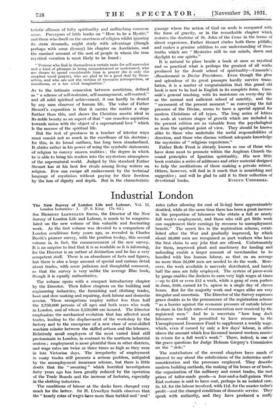Industrial London
The New Survey of London Life and Labour. Vol. IL London Industries! I. (P. S. King. 17s. 6d.) Sin HERBERT LLEwELLYN SMrru, the Director of the New Survey of London Life and Labour, is much to be congratu- lated on the new volume of this valuable and fascinating work. As the first volume was devoted to a comparison of London conditions forty years ago, as revealed in Charles Booth's pioneer survey, with the position to-day, this second volume is, in fact, the commencement of the new survey. It is no surprise to find that it is as readable as it is informing, for the Director is an author of distinction and he has a very competent staff. There is an abundance of facts and figures, but there is also a large amount of special and curious detail about trades, with some judicious and thoughtful comment, so that the survey is very unlike the average Blue book, though it is equally authoritative.
The volume opens with a compact introductory chapter by the Director. Then follow chapters on the building and engineering industries, the furnishing and clothing trades, boot and shoe making and repairing, dock labour and domestic service. These occupations employ rather less than half the 3,750,000 persons of all ages and both sexes who work in London, and of whom 2,250,000 are insured. The Director emphasizes the mechanical evolution that has affected most trades, leading to the displacement of the workshop by the factory and to the emergence of a new class of semi-skilled machine minder between the skilled artisan and the labourer. Relatively small employers of the most varied kind still predominate in London, in contrast to the northern industrial centres ; employment is more plentiful than in other districts, and wage rates are twice or three times as high as they were in late Victorian days. The irregularity of employment in many trades still presents a serious problem, mitigated by the unemployment insurance scheme, but there is little doubt that the " sweating " which horrified investigators forty years ago has been greatly reduced by the operation of the Trade Boards and the increase of factories, especially in the clothing industries.
• The conditions of labour at the docks have changed very Much for the better. Sir H. I2ewellyn Smith observes that the " hourly rates of wages have more than trebled and real '
rates (after allowing for cost of living) have approximately doubled, while at the same time there has been a great increase in the proportion of labourers who obtain a full or nearly full week's employment, and those who still get little work can supplement their earnings by recourse to unemployment benefit." The secret lies in the registration scheme, estab- lished after the War and gradually improved, by ,which about 36,000 men are recognized as part workers who have the first claim to any jobs that are offered. Unfortunately for them, improved plant and machinery for landing and unloading enable a larger amount of merchandise to be handled with less human labour, so that on an average no more than 26,000 men are needed to do the work. More- over, the work available is unevenly distributed, and barely half the men are fully employed. The _system of piece-work by gangs enables the dockers to earn very high wages at times —up to £10 or even £15 a week, while a gang of corn porters in June, 1930, earned £4 7s. apiece in a. single day of eleven hours. But for the majority work and wages, alike are very irregular and uncertain. The Director of the Survey expresses grave doubts as.to the permanence of the registration scheme " as a barrier against the economic pressure of outside labour to share in the high rates of remuneration now received by the registered men." And he is uncertain " how long dock labourers would be permitted to have recourse to the Unemployment Insurance Fund to supplement a weekly wage, which, even if earned by only a few days' labour, is often above the amount which less favoured insured workers receive in return for a full week's work." There, indeed, is one of the grave questions for Judge Holman Gregory's Commission on the " dole."
The contributors of the several chapters have much of interest to say about the subdivisions of the industries under consideration and the processes employed. They describe modern building methods, the making of tin boxes or of boots, the organization of the millinery and corset trades, the cost prices of tailor-made goods—a four-and-a-half-guinea West End costume is said to have cost, perhaps in an isolated case, 5s. ld. for the labour involved, with 11d. for the master tailor's profit—and the changed conditions of domestic service. They speak with authority, and they have produced a really
attractive book, the key-note of which is hopefulness. Much, no doubt, remains to be done, but London labour is very much better off, in every way, than it was a generation ago.







































 Previous page
Previous page